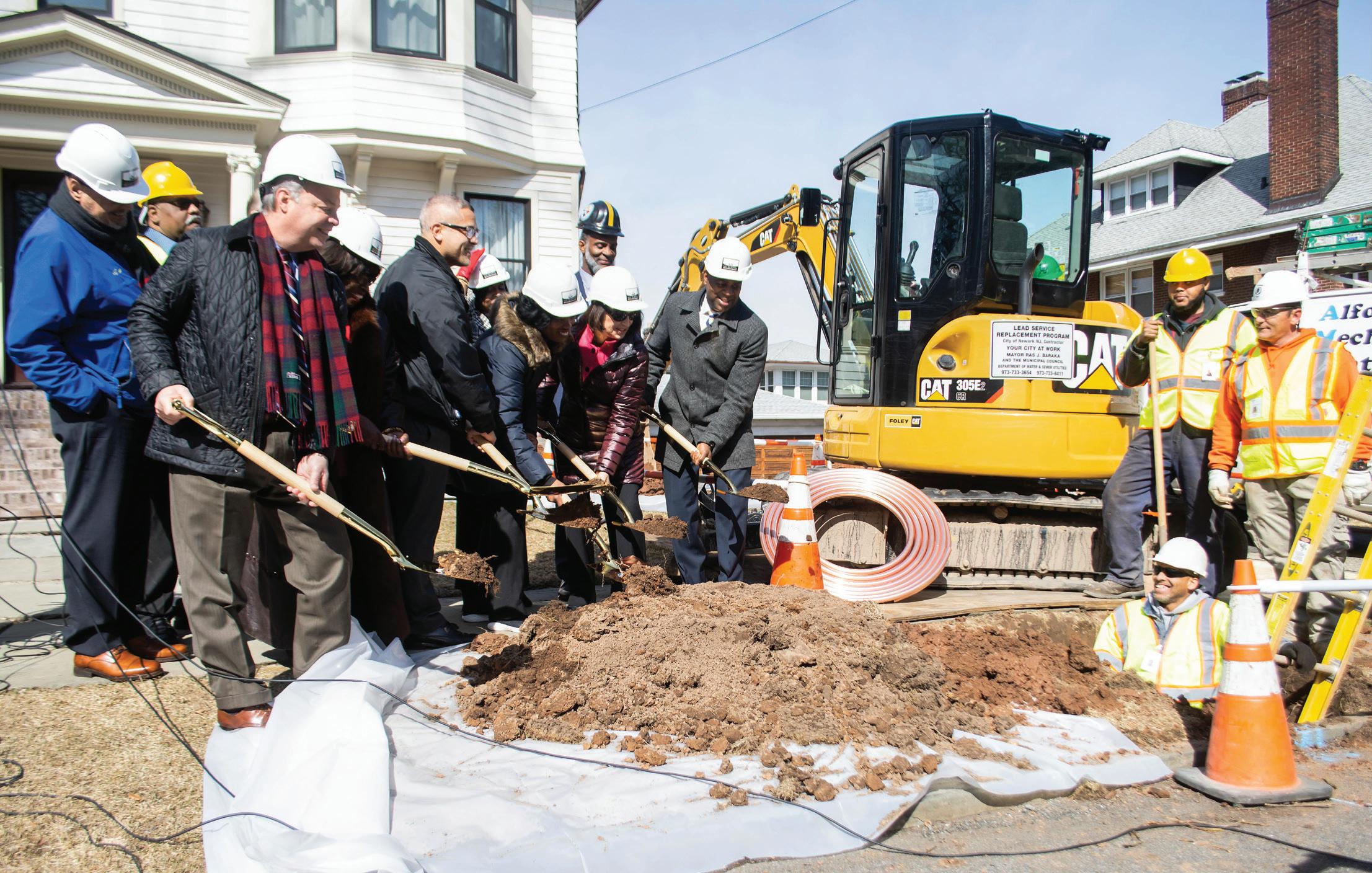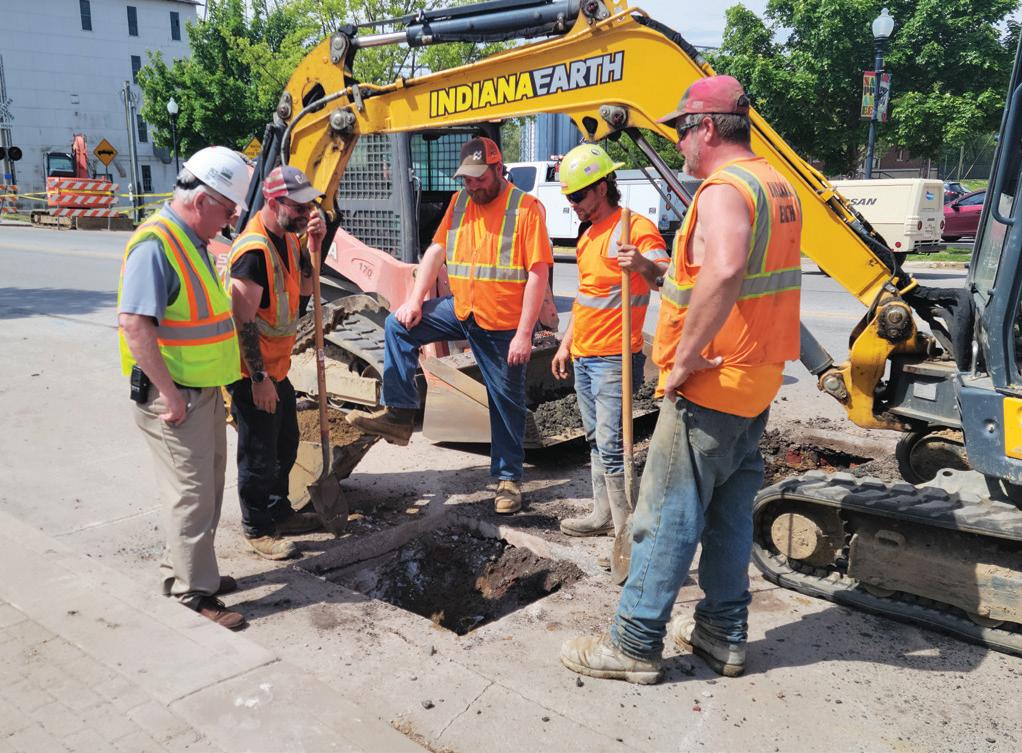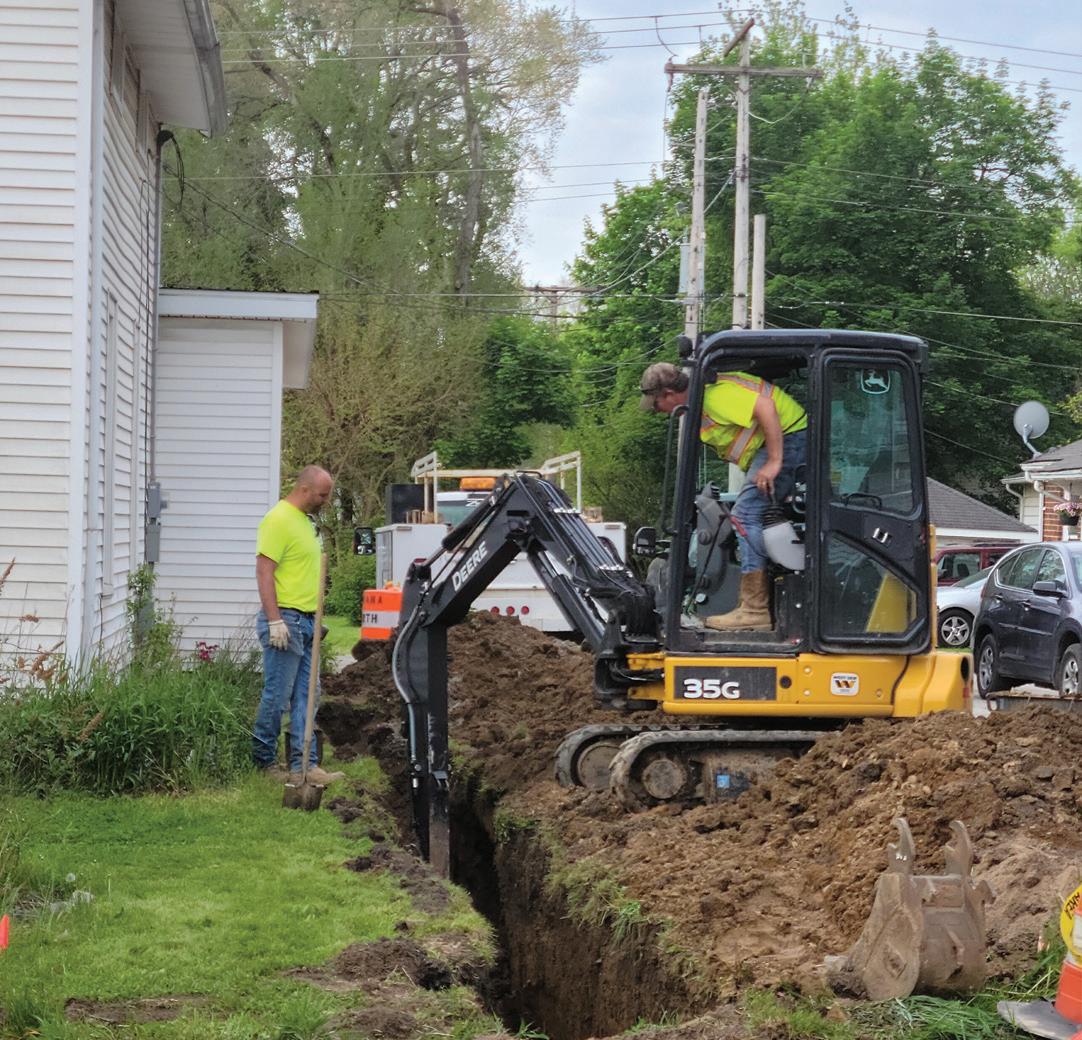
15 minute read
Focus on Public Works
Workers replace lead service lines in a Newark, N.J., neighborhood. The city accelerated its program to replace the lines in two to three years instead of eight to 10. It expects work to be completed in a month or so. (Photo provided)
Newark accelerates its lead line replacements
By DENISE FEDOROW | The Municipal
There’s no denying that the Flint, Mich., water crisis in 2014 shone a light on the issue of lead in drinking water and the potential hazards lurking underground in many cities and towns. There’s also no denying the nation’s infrastructure—including water mains—is aging and in need of replacement.

Officials in Newark, N.J., said thanks to the collaborative efforts of government officials and private parties, they’ve made “remarkable” progress in replacing the lead lines in the city, one of the oldest in the U.S. They could accelerate what was initially expected to be an 8- to 10-year project to a two- to three-year one.
Director of Water and Sewer Kareem Adeem said Newark’s first lead lines were installed in the 1850s, with the last one being installed in 1952. The city has good records going back that far, and through them, there are 18,700 known and another 6,000 unknown lead lines, for a total of 24,000. As of mid-May, the city has already abated almost 22,000 households and 19,000 lines.
Adeem said it was June 2017 when officials notified and provided data to the Environmental Protection Agency that the city had its first exceedance violation in 25 years. The city tested a sampling of 100 homes, and 11 of them tested over the allowable 15 parts per billion.
The prior year, in 2016, a school system had lead in its water, but officials found there was no connection to the city’s lines. Once that was discovered, then governor, Chris Christie, ordered testing for 150 of the largest schools in the system. It was at that time, the New Jersey Department of Environmental Protection Newark Water and Wastewater Director Kareem Adeem speaks at a town hall meeting while holding up a segment of copper pipe. (Photo provided)
Agency came up with new testing requirements for all water purveyors, according to Adeem.
Officials later discovered under a prior administration around 2010-2013, the city had “struggled to meet simultaneous compliance,” and a change in the sodium silicate at that time could have played a part in later effectiveness of protecting the pipes from corrosion.
Newark city officials get in the act with shovels at an area working on replacing lead service lines. (Photo provided)

Adeem has been with the city for 30 years, 24 to 25 of them with the water department. Water and Wastewater Spokesperson Mark Di Ionna said after the former superintendent passed away in November 2018, Newark Mayor Ras Baraka “felt confident enough in him” to put him in charge in the middle of this challenging time. Di Ionna praised the work Adeem has done.
The city of Newark is served by two water treatment plants. The Pequannock plant serves half the city, and it was that portion of the city where issues were occurring. The Wanaque treatment plant serves the other half of the city, and there were no issues at that plant. After the first exceedance, the city began holding community meetings and sending out press releases, mailings and other forms of communication to inform the residents.
In August 2017, Gov. Christie and the NJDEP launched a campaign with a $30 million fund to start replacing lead service lines across the state and ramped up required testing.
“Newark started engaging with the state as early as the summer of 2017,” Adeem said.
In fact, he reported Newark had an application in with the state as early as 2012 to replace lead service lines with state revolving funds, but the money wasn’t there yet. In March 2018, the city launched its lead service line replacement program, and for several months, workers went door-to-door informing residents of the program while handing out test kits and water filters.
Adeem said they went block by block to every house because they wanted residents to know they weren’t skipping anyone and could verify when they knew their house—because it was built later—did not have a lead line.
The city invested $195 million into this program, and in June 2018, the city of Newark passed a bond ordinance of $75 million. Adeem said the city also received $120 million through the county. Another thing the city did that most municipalities have not done, according to Adeem, is test the filters workers had handed out after they were in use. This testing found three of them were not performing as expected “under extreme conditions.”
Adeem said with “an abundance of caution,” the city distributed bottled water for two months — August through September 2019.
Legislation passed
There were two pieces of legislation passed, which accelerated Newark’s lead service line program.
In June 2018, a collaborative effort between the city of Newark, the governor’s office and the Essex County Delegation created an amendment to legislation, allowing the use of public funds on private property for the purpose of replacing lead service lines going into homes. The legislation passed Aug. 18, 2018, and was signed by Gov. Phil Murphy.
The city also passed legislation allowing them to go on private property without the homeowner’s permission. The “right of access” ordinance passed in September 2019. Adeem said this was critical because 70% of the properties are rentals.
“Sometimes there’s like five layers to get through to find the property owners,” and Adeem noted the owners might not give permission because of fear the city might find other violations.
Creating economic growth
Adeem and Di Ionna said the mayor wanted to ensure if the city was spending all this money,
that a large portion of it would be returning to the city. According to Adeem, the mayor set up programs to get “mom-and-pop businesses in the city proper licenses to bid on government contracts,” which would allow them to bid on county and school projects, too.
In addition, the water department required contractors to hire Newark residents. He said 50 unemployed Newark residents were sent for apprenticeships and 35 were placed on the lead service line replacement project.
“Residents who live in the city got union-scale jobs,” Adeem said. “We used it as an economic engine, putting money back into the city. We had residents replacing their own lines or their neighbor’s lines.”
He said this was especially helpful when workers were going doorto-door because residents saw their neighbors or their nephews were working on the project.
“They see us out on the street, see us expediting the program and that we really cared—cared enough to the point of ensuring money was going back into the city; that we hired residents and helped them learn a trade.”
This also helped get Newark residents on board. “Residents rallied with us to get the lead service lines replaced,” Adeem said.
Adeem said Newark residents are 70% black and brown, and the mayor is investing in the community with the thought, “We’re no longer going to allow companies to take money out of our community.”
Lessons learned
Adeem and Di Ionna talked about what the city did right and what it could’ve done better. Di Ionna said he thinks it goes back to an initial conversation between the mayor and Adeem when this first began. The mayor asked Adeem how the city could fix this, and Adeem said pull out the lead lines. The mayor asked how much would it cost, and Adeem replied probably $150 million.
“The mayor’s response was ‘Let’s figure out a way to do it.’ He didn’t want to kick the can down the road,” Di Ionna said.
Adeem said one thing the city did right was “we weren’t afraid to think outside the box. We gave out water filters almost immediately, (and) we tested the filters; no one’s ever thought of that. We gave out bottled water, we hired Newark residents; we got the money so we could accelerate the program.”
“Treat it like the public health emergency it is and fix it,” he added.
Di Ionna said, “The short answer to what the city did right was the will to get it done. We had the will to get legislation passed to use public funds on private property, we had the will to get legislation to allow us to go on private property, we had the will to take port authority money and throw it at this program, (and) we had the will to work with the county and state to get it done. The theme of this is ‘How do we get it done?’”
“And to get it done in the most economic, effective and efficient manner,” said Adeem. “For generations to come, kids in the city of Newark will not be affected by lead levels going into the water, and another mayor will not have to worry about it.”
As for what the city could’ve done better, Adeem said, “When we first started communicating with residents, we didn’t use social media to the level we should have and that we’re doing now.”
Officials followed regulations and sent out mailings, put notices on water bills, etc, but they realized state and federal guidelines could be enhanced through the addition of social media. People said the city was downplaying the issue because they weren’t on social media.
“When we improved communication by using Facebook, Instagram, etc. in 2018, we saw results—residents embraced us and came on board and pushed back against the NRDC (Natural Resources Defense Council),” Adeem said, noting the NRDC had filed a lawsuit against the state and city “demanding” Newark do a variety of things it had already implemented before the lawsuit was filed.
Adeem also said the city could’ve been more aggressive about trying to get its side of the story out about what it was doing to correct the issue.
Newark’s advice
Newark officials advise municipalities not to wait. “Start having those conversations with your community now. Make sure you have an inventory of your lead service lines—don’t wait till the last minute,” Adeem advised. “Work on a strategy on how to replace the lead service lines effectively, economically and efficiently and move forward. Don’t sit on the sidelines. Have a plan in place—don’t kick the can down the road.”
Di Ionna said, “No city the size of Newark has done as many as we have as quickly at no cost to and no rate increase to residents. What we’ve done is pretty remarkable.”
Adeem said the city is getting calls from around the country and as far away as Germany asking how it accelerated the program.
Keeping the program free to homeowners is key. Adeem said when Newark first launched the program, it was charging $1,000, and only 750 lines were replaced in six months. Once the city made it free, workers replaced 1,200 in one month.
Adeem said the program has given city officials “a level of pride on a national level that you can create a jobs plan for every community if you upgrade the city’s infrastructure.”
He added, “The country needs to have a real conversation about the real cost of water.”

Nappanee Water and Wastewater Superintendent Gale Gerber (yellow vest, white hard hat) looks at a new opening alongside contractors, who are working on the city’s water main project and lead line replacement project. The city is taking advantage of a program through the State Revolving Fund that allows it to use interest on its loan to replace lead lines. (Photo provided)
Proactive in Nappanee, Ind.

Contractors from Indiana Earth work along South Main Street in Nappanee’s downtown replacing aging water lines. (Photo by Denise Fedorow)
The city of Nappanee has taken a proactive approach to lead service line replacement. The city’s water main was installed in 1892, and despite being that old, Water and Wastewater Superintendent Gale Gerber said the pipes are not lead, but the joints and goosenecks are. The city has not had any instances of lead exceeding recommended levels.
He said the pipes under the city are cast iron, ductile iron, asbestos concrete and PVC. And even though there is a protective barrier between the lead joints and the water, the city is taking the opportunity to replace those potentially problematic joints.
Gerber explained after what happened in Flint, Mich., Congress decided it needed to do something and made funding available to the states for local communities like Nappanee to be able to draw from.
The funding is available through the State Revolving Fund. When a city or town has a water project funded through SRF, the amount it would’ve paid in interest on that loan can instead be utilized to replace lead service lines.
James McGoff, COO and director of Environmental Programs for the Indiana Finance Authority, said, unlike New Jersey, the state of Indiana did not need to pass any legislation in order to use public funds on private property.
According to a fact sheet about the program dated April 2021, “The Drinking Water State Revolving Fund Loan Program offers a reduced interest rate incentive for communities to include lead line replacement as part of their SRF projects. Lead line replacement projects include replacing complete lead and galvanized service lines. Based on the type and cost of these components, a community may be eligible for improved ranking on the SRF Project Priority List, as well as an interest rate as low as $0.00% on its SRF loan.”
The fact sheet goes on to state, “(the) SRF will only finance complete lead service line replacement projects. That is, the SRF will only finance projects that replace the entire service line from the public water main to the point at with the line connects to the customer’s premise plumbing.”
McGoff said, “We provide financing for both stand-alone lead service line replacement projects or those coupled with another project. The most economical time to replace the lead service lines is at the same time as a service main is being replaced.”
The city is also able to replace what would’ve been the property owner’s portion of the line up to one foot of the house or business. Gerber said that cost could vary anywhere from $2,500 to $3,000.
Nappanee is currently replacing a portion of its water main in the downtown area and other parts of the city. There have been multiple leaks along the aging water main. City officials contacted homeowners and obtained 264 easements.
Gerber said some decided not to participate; however, he noted when workers went door-to-door, “We tell them here’s an opportunity, do it or not.”
Some even preferred to hire their own plumbers.
Mayor Phil Jenkins said, “We can’t reduce all chances of lead — if they have lead in their house, for example, but we can significantly reduce the chances.”
Gerber said part of the requirement of the grant is that after the city gets residents hooked up, someone from the water utility has to go in and take the water meter out and flush the system before reinstalling the meter.
The first time the city took advantage of the program was in 2018 when it had an infrastructure project with new wellheads at Wellfield Park. It used the interest from that project to replace lead service lines on South Main and North Main streets—some of the oldest in the city.
Gerber believes Nappanee was the fourth city in the state to take advantage of the program and learned about it from the city’s engineers and financial consultants.
Mayor Jenkins said he thinks some “ignore the issue because it’s underground, and they don’t see it or they don’t have the funding to do it.”
Gerber said after the Flint disaster, the city had to have a sampling site plan of 40 homes. “I’m thankful for those people who were willing to participate in the program,” and the city passed without any exceedance of the allowable 15 ppb at 90 percentile.
Nappanee also tested the schools and daycares in town at that time. Gerber credited the polyphosphate the city uses to coat the pipes with keeping the water from corroding the pipes. He also credits the
administration for open communication and being proactive. “I feel we’re providing a great service to our citizens,” Gerber said.
The mayor agreed, saying, “I like to think we’re being proactive.”
Jenkins offered this advice to other communities. “Do an inventory of the age of the pipes in your system and get a good database, so you know the type of pipes you have and the risk based on the condition, the type of soil they’re in and then look at a long-term strategy asset management plan to regularly replace them.”
Gerber said now that the city has a written asset management plan, it’s helpful for planning these projects financially.
“We used to go until things fell apart and order an emergency fix — it’s best to be proactive,” he said. “Another key factor is that the administration needs to know what’s going on with the utilities so they can properly fund.”
Future lead service line replacement in Nappanee will be based on that asset management plan, and there are further projects planned because of the aging infrastructure.
Asked how much help it was to have the state and federal assistance, Jenkins replied, “There’s no way we’d be able to do what we’ve done without the help of federal and state programs. We hope more funds will be available for infrastructure — it costs a lot to maintain. Create an asset management plan as a way to fund projects with the cooperation of local, state and federal agencies.” Contractors working on the Nappanee water main replacement project are also replacing lead service lines going into homes as part of the project. (Photo provided)




